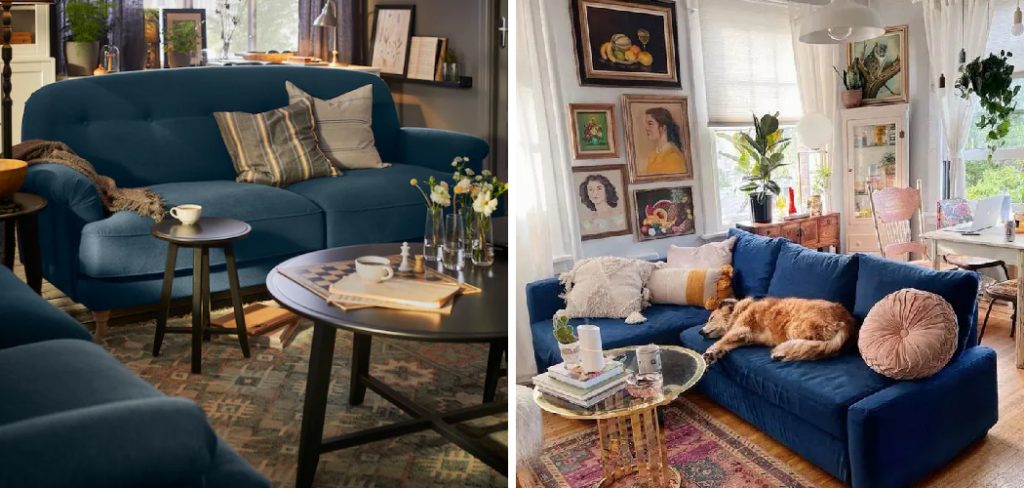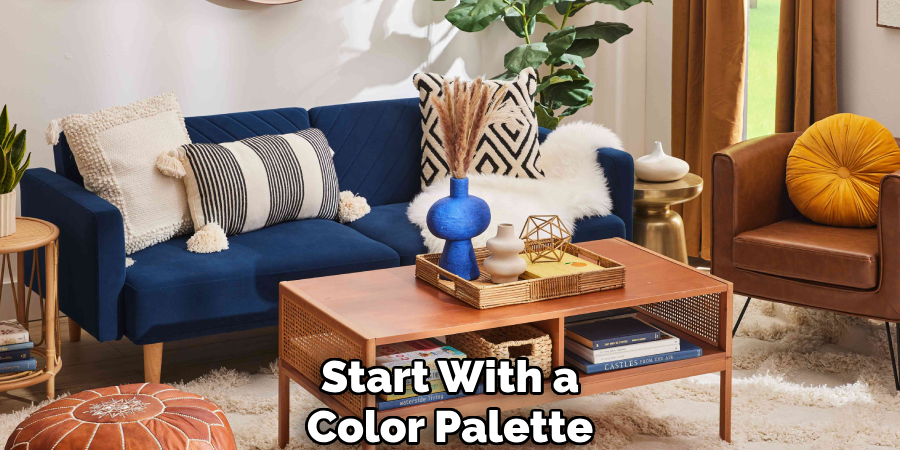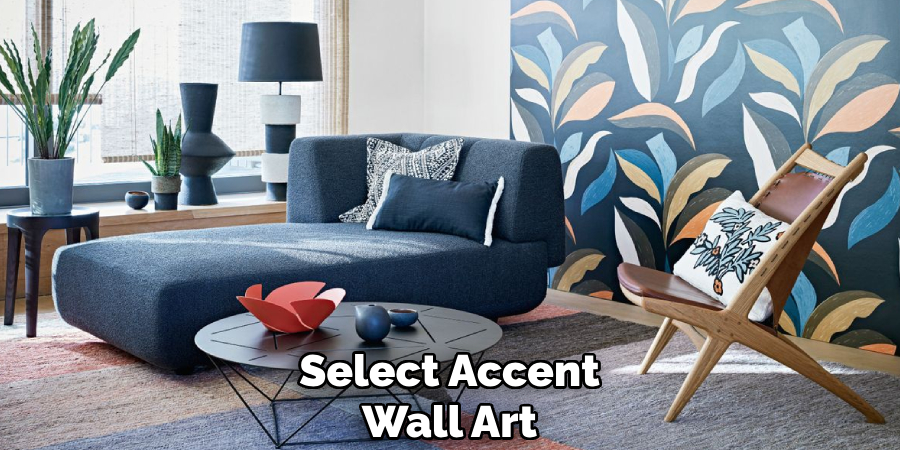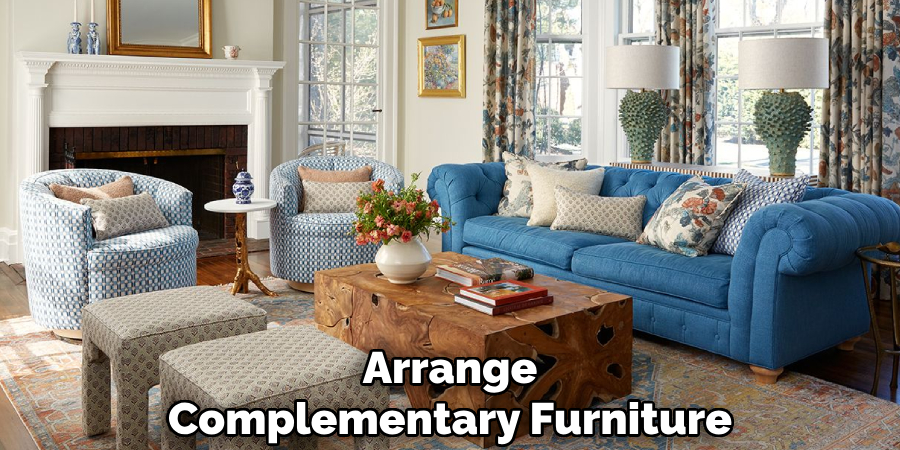Are you tired of seeing your old blue couch looking dull and lifeless? Or maybe you just want to add a pop of color to your living room?

A blue couch can be a bold and versatile centerpiece for any living space. Its vibrant and calming hue adds character while remaining adaptable to various design styles. Whether your aesthetic leans toward modern minimalism, cozy farmhouse, or eclectic charm, a blue couch offers endless possibilities for creating a cohesive and inviting atmosphere. Additionally, blue is associated with feelings of tranquility and relaxation, making it a perfect choice for a comfortable and stylish seating option.
In this guide on how to style a blue couch, we will provide tips and ideas on how to incorporate this versatile piece of furniture into your home decor.
What Are the Benefits of a Blue Couch?
- Versatility
A blue couch can be styled in various ways, making it a versatile piece of furniture. It can easily blend in with different color schemes and decor styles, from neutral and monochromatic to bold and vibrant.
- Timeless Appeal
Blue is a classic color that never goes out of style. Whether you choose a light or dark shade, your blue couch will always remain stylish and relevant, making it a worthy investment for your home.
- Calming Effect
As mentioned earlier, the color blue is associated with feelings of calmness and relaxation. Adding a blue couch to your living space can create an inviting and peaceful atmosphere, perfect for unwinding after a long day.
- Suitable for Any Room
Whether you want to add a blue couch to your living room, bedroom, or even home office, it will fit in seamlessly. Blue is a gender-neutral color that works well in any space, making it a great choice for any room in the house.
What Ingredients Will You Need?
To create a truly inviting living space with a blue couch, you will need more than just the couch itself. Here are some additional elements to consider:
- Accent Pillows
- Throw Blankets
- Rugs
- Coffee Table
- Accent Pillows
- Wall Art
- Lighting
- Curtains or Window Treatments
- Greenery or Plants
- Other Furniture Pieces (e.g., side tables, ottomans)
10 Easy Steps on How to Style a Blue Couch
1. Start with a Color Palette
Before you begin styling your blue couch, it’s crucial to establish a cohesive color palette for the room. Begin by considering the shade of blue on your couch—is it a rich navy, a calming sky blue, or a vibrant teal? This will help determine complementary colors that work harmoniously with it. Neutral tones like white, beige, or gray create a balanced and serene atmosphere.

Alternatively, if you’re looking for a bolder look, pair your blue couch with contrasting colors such as mustard yellow, coral, or even emerald green for a dramatic and modern touch. Remember to seamlessly tie the entire look together with your chosen palette across various elements in the room, including the pillows, rugs, and wall art. A well-thought-out color palette serves as the foundation for a stylish and inviting space.
2. Layer Accent Pillows
Accent pillows are one of the easiest and most versatile ways to enhance the aesthetic of your blue couch while also adding comfort. Start by selecting pillows in varying sizes, shapes, and textures to create a dynamic and visually engaging arrangement. Mix and match patterns like geometric prints, florals, or abstract designs, but stay within your chosen color palette for a cohesive look. Layering pillows in complementary tones or subtle contrasts can add depth and intrigue to your seating area.
3. Incorporate a Throw Blanket
A throw blanket is essential for creating a warm and inviting space, blending function and style. When selecting a throw blanket, consider the material and texture to complement the other elements in your seating area. Opt for soft, luxurious fabrics such as faux fur, chunky knits, or lightweight cashmere to add depth and substance to the overall aesthetic.
Play with colors and patterns that match your decor for a cohesive look or introduce a bold accent to make a statement. For placement, drape the throw loosely over the arm of a sofa or across the back of a chair to achieve a casual, effortless style that encourages comfort. Alternatively, fold it neatly and layer it over the seat or a bench for a more tailored appearance.

4. Use a Coordinating Rug
A carefully chosen rug can transform the look and feel of any space, serving both functional and aesthetic purposes. When selecting a carpet, consider its size and shape about the room and furniture layout. A properly sized rug should anchor the space, with larger options extending under furniture pieces such as sofas, chairs, or dining tables to unify the arrangement.
Pay attention to the material, opting for durable options like wool or synthetic blends in high-traffic areas, while using plush or more delicate materials in quieter spaces, such as bedrooms. Coordinating the rug’s color and pattern with your existing decor is essential for creating a harmonious look. For instance, a bold, patterned rug can be a focal point in a neutral-toned room, while a more subdued, solid design balances spaces filled with colorful or intricate elements.
5. Position a Coffee Table
Positioning a coffee table is both a functional and aesthetic decision that significantly impacts the flow and usability of a living space. When placing your coffee table, consider its proximity to the surrounding furniture, particularly the sofa and chairs. Ideally, there should be about 16 to 18 inches of space between the coffee table and seating to allow easy access while leaving enough room for leg movement.
The size and shape of the coffee table should correspond to the dimensions of the seating arrangement. For instance, a rectangular table is a classic choice for longer sofas. In contrast, a round or oval table complements sectional seating or smaller spaces, offering smoother edge contours that are both safer and visually softer.
6. Select Accent Wall Art
Choosing the right accent wall art can transform the look and feel of a room, adding character and expressing personal style. Start by considering the overall theme and color scheme of your space. Wall art should complement these elements while providing a focal point or visual interest.

Larger pieces work well in spacious areas, creating a bold statement, while more miniature artworks can be grouped for a gallery effect. Materials and textures can also play a critical role—canvas paintings, metal sculptures, or wooden carvings bring distinct elements of depth and dimension.
7. Add Thoughtful Lighting
Lighting plays a pivotal role in setting the tone and ambiance of a room, as well as highlighting key features within the space. Begin by layering different types of lighting—ambient, task, and accent—to achieve a balanced and versatile atmosphere. Ambient lighting, such as ceiling fixtures or pendant lights, provides overall illumination and lays the foundation for the room’s brightness.
Task lighting, however, is designed to serve specific functions, such as a desk lamp for focused work or under-cabinet lighting in the kitchen. Accent lighting, like spotlights or wall sconces, is ideal for drawing attention to decorative elements such as artwork, architectural features, or textured walls.
8. Frame the Space with Curtains
Curtains play a vital role in framing a space and can dramatically alter the atmosphere of a room. They perfectly balance style and functionality, allowing you to control light, maintain privacy, and add visual interest to the decor. When selecting curtains, consider the fabric, color, and pattern to ensure they harmonize with the room’s overall aesthetic. For a cozy, inviting feel, opt for heavier materials like velvet or layered designs, while sheer or lightweight fabrics can create an airy, open ambiance.
9. Place Greenery Nearby
Adding greenery to your space is one of the simplest yet most effective ways to breathe life into a room. Plants enhance the aesthetic appeal, improve air quality, and create a sense of tranquility. To make the most of greenery in your decor, choose plants that suit the lighting and temperature conditions of the space. For low-maintenance options, consider succulents or snake plants, which are hardy and require minimal care. If you want to make a statement, larger plants like fiddle leaf figs or monstera add a striking focal point.
10. Arrange Complementary Furniture
When arranging complementary furniture, it’s essential to consider both functionality and harmony within the space. Start by identifying the room’s focal point, whether it’s a fireplace, a window with a beautiful view, or even a statement piece of furniture.
Once the focal point is established, position your furniture to draw attention to it while maintaining a natural flow through the room. Balance is key—avoid overcrowding the space by ensuring there is adequate room to move and that pieces are proportional to the area’s dimensions.
By following these steps, you can turn your blue couch into a stunning centerpiece that defines the room and reflects your personal style.

Conclusion
How to style a blue couch effectively revolves around achieving harmony between your furniture, décor, and overall color scheme.
You can enhance the couch’s visual impact without overwhelming the space by selecting complementary colors, textures, and accents. Additionally, incorporating a variety of materials and patterns creates depth and interest, tailoring the room to your unique preferences.
Ultimately, the key is to strike a balance that highlights the blue couch as both a functional and aesthetic centerpiece, ensuring it seamlessly blends style with comfort.
Huston Douthit is a distinguished figure in the world of furniture design, with a decade of expertise creating innovative and sustainable furniture solutions. His professional focus lies in merging traditional craftsmanship with modern manufacturing techniques, fostering designs that are both practical and environmentally conscious. As the author of Fruniturix, Huston delves into the art and science of furniture-making, inspiring artisans and industry professionals alike.
Education
- RMIT University (Melbourne, Australia)
Associate Degree in Design (Furniture)- Focus on sustainable design, industry-driven projects, and practical craftsmanship.
- Gained hands-on experience with traditional and digital manufacturing tools, such as CAD and CNC software.
- Nottingham Trent University (United Kingdom)
Bachelor’s in Furniture and Product Design (Honors)- Specialized in product design with a focus on blending creativity with production techniques.
- Participated in industry projects, working with companies like John Lewis and Vitsoe to gain real-world insights.
Publications and Impact
In Fruniturix, Huston shares his insights on furniture design processes, materials, and strategies for efficient production. His writing bridges the gap between artisan knowledge and modern industry needs, making it a must-read for both budding designers and seasoned professionals.


